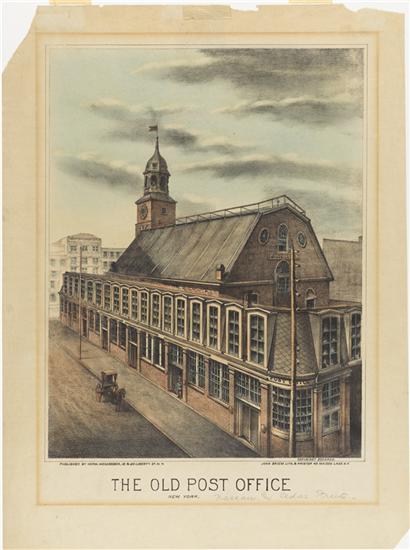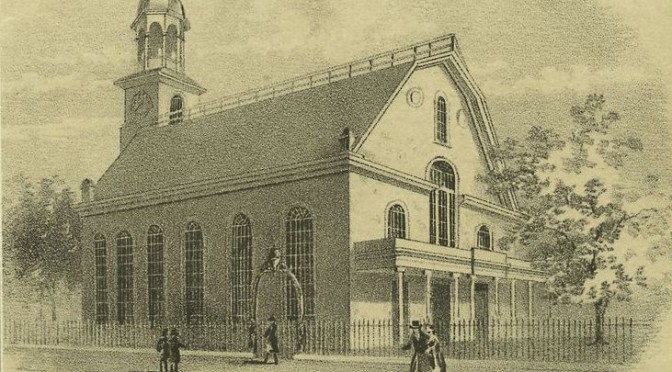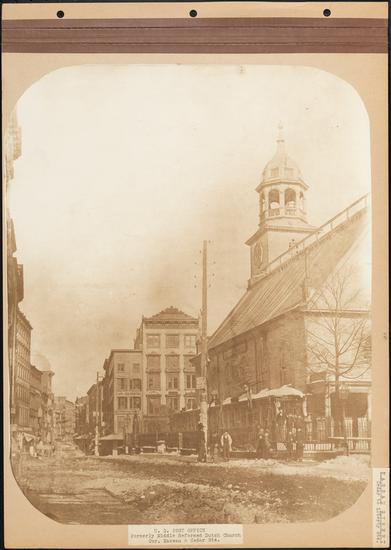
One need only walk past the old Limelight in the neighborhood of Chelsea to understand the strange flexibility of church architecture.
This former Richard Upjohn-designed Episcopal church at West 20th Street and Sixth Avenue was transformed into a rehab center in the 1970s, then a notorious nightclub in the ’80s, then an upscale mall. And now a gym.
But the Limelight is only the most extreme example of church alteration in New York. Brooklyn Heights has so many churches that some have been turned into swanky loft apartments.
This is not a new trend. New York grew so rapidly in the 19th century that small stone and clapboard churches, once situated on the outskirts of town, found themselves surrounded. As population shifted, congregations left, and other civic services moved in.
The Middle Dutch Church was built between 1726 and 1731, a vestige of Manhattan’s Dutch Reformed community that traced itself back to New Amsterdam‘s very first house of worship.
Its location at Nassau Street and Cedar Street made it central to the lives of colonial New Yorkers, but a series of historical twists ensured a few less hallowed activities would take place here.

During the Revolutionary War, the occupying British turned the damaged and deteriorating Middle Dutch and its neighboring sugar house into a prison for unruly rebels.
An old Times article estimates that up to 8,000 prisoners were held here in those years. “When the victims confined to the Middle Dutch church crawled to the windows begging for food, a sentinel, pistol in hand, would turn back the gifts of the charitable.” [source]
“The whole floor of the Church was one caked mass of dead, dying, excrement and vermin,” reported the Times, “supernatural” conditions that probably echoed throughout the entire city, choked off during the occupation years between 1776 to 1783.
I’m grimly speculating that prisoners were transferred the prison ships of Wallabout Bay at some point, for the building was emptied, “the planking torn up, tan laid down, and a riding-school established for the recruits of the English riding-horse.”
When the British galloped out of New York entirely in 1783, the beat-up old building sat virtually unused — although Benjamin Franklin may have used the belfry for electricity experiments, according to one source — before being turned back into a church, re-opening on July 4, 1790.
It stayed as a church for 44 years, even as New York’s population migrated north. Finally, under a cloud of debt, the church permanently closed in 1844, with its final service symbolically held in both English and Dutch languages.
If Franklin (America’s first postmaster general) indeed practiced with electricity here, then the next transformation seems natural.
With the federal standardization of postal rates in 1845, New York found itself in need of a central post office. So the U.S. government leased the old church — buying it outright in 1861 — and radically transformed the building into New York’s central post office.

The poor building, renovated and stretched thin, could barely process the flow of mail coming through the city by the late 1860s, so a new central post office was built — the odd, greatly loathed City Hall Post Office building.
The old Dutch church, now 150 years old, was considered a city treasure, but real estate in downtown Manhattan was now being carved out for skyscrapers.
Below: The post office/church in an 1877 lithograph, courtesy the Museum of the City of New York

The church of a thousand faces, to the curiosity of “thousands of relic-hunters and citizens,” was finally torn down and replaced with the Mutual Life Insurance Building in 1882.
The ornate Mutual Life had a good run but was demolished — with a part of Cedar Street erased — to make room for One Chase Manhattan Plaza.
And finally — perhaps the only existing photograph of the old post office, dated 1890, Nassau Street – Cedar to Liberty Sts. (courtesy the Museum of the City of New York)



5 replies on “From prison to post office: The odd fate of a Dutch church”
Don’t forget the Church of the Apostles in Melville’s Pierre!
http://www.gutenberg.org/files/34970/34970-h/34970-h.htm#BOOK_XIX
Hi, you are aware there are photos of this, right?:
http://digitalgallery.nypl.org/nypldigital/dgkeysearchdetail.cfm?trg=1&strucID=759430&imageID=g91f212u_027f&total=51&num=20&r=02fPost%2520offices%2520%252D%252D%2520New%2520York%2520%2528State%2529%2520%252D%252D%2520New%2520York%4002fStereographs&word=&rOper=2&stype=Rel&rSource=&rDiv=Photography%20Collection,%20Miriam%20and%20Ira%20D…&rCol=United%2520States%2520in%2520Stereo%253A%2520In%2520the%2520Robert%2520N%2E%2E%2E&s=3¬word=&d=&c=&f=&k=0&imgs=20&pos=38&e=w
http://digitalgallery.nypl.org/nypldigital/dgkeysearchdetail.cfm?trg=1&strucID=759406&imageid=g91f212u_024f&total=1&e=w
http://www.picturehistory.com/product/id/1593
Thanks for posting those links Jay!
I have on my desk a relic of the Middle Dutch Church: a piece of one of the pews. It is a solemn reminder of a church being used a torcher chamber for prisoners by the British. I also worked at 1 Chase Plaza. I wonder if any know of the former tenants of the land below……
That is a very interesting relic- how did you get it? I would be very interested in finding one of my own.